Rose Geisha
Very often, breeding varieties of different crops bear the same name, but have differences in appearance and different creators. This confusion was not spared and the most beautiful of all flowers - a rose. If you carefully study the available information, you can find as many as 4 Geisha - 2 floribundas, 1 hybrid tea and 1 multiflora. To clarify the situation a little, let's get to know each of them.
Roses from Tantau
I would like to start acquaintance with beautiful strangers with the German rose-growing company Tantau. After all, it is she who owns two of the known varieties.
Geisha (TANshei)
This variety is a novelty in the rose-growing world, created by Tantau in 2005 under the leadership of Hans Jürgen Ewers. Despite such a young age, the species is in high demand among gardeners due to its delicate and romantic appearance. Registered name - Geisha, in the floriculture market known as TANshei. The variety is excellent for planting in small groups or large tracts, used for cutting.
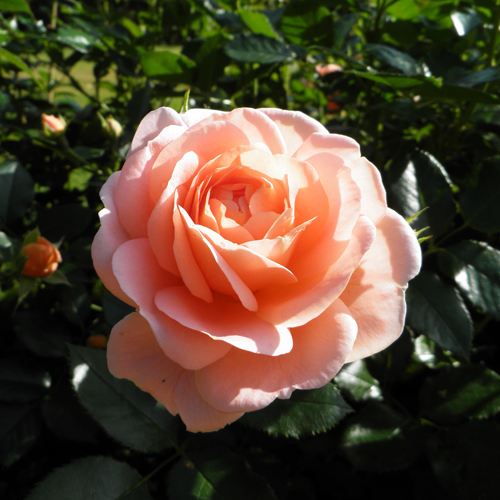
Description
This Geisha is a Floribunda. The bush is vigorous, branched. The usual height is 50 - 80 cm, but not higher than 1 meter. If properly formed, the volume of the bush should not exceed 60 cm. The foliage is good. Leaves are dark green, glossy. The stems of the rose are not thick, but firm.
The flower is cupped. Dissolving, the petals are bent back, often revealing the stamens. The outer petals are large, with wavy, slightly serrated edges. The inner ones are smaller. The color is charming and delicate - an apricot-orange hue that gradually brightens as it fades. The flower is semi-double, small in size - about 5 - 6 cm. But it does not appear on the shoot singly, but in an inflorescence of 3 - 5 buds.
Bloom
The flowering of the rose is profuse and long lasting. During this period, the Geisha looks very elegant, she is literally strewn with pink bouquets of inflorescences. After the first wave of flowering, the formation of buds continues, in this rhythm the variety will delight the grower until October (in warm regions). It can bloom three times per season.
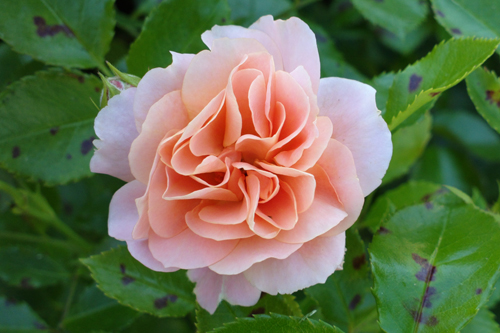
Characteristics
- The frost resistance of the variety is not bad, it can withstand temperatures down to -23.3 ° C, which, according to the US Department of Agriculture (USDA), corresponds to zone 6:
- the rose has good immunity, resistance to powdery mildew and black spot is average, but severe damage by these diseases is possible only in unfavorable years;
- Geisha is well suited for cutting, densely spaced petals keep their shape ideally for 7 to 10 days;
- The smell of flowers is weak, but on a calm day near the bush you can catch a thin veil of a delicate sweet aroma;
- the plant is able to survive dry periods, but only if they are short-lived;
- the buds are resistant to rain, do not stain from dampness, do not fall apart;
- during a period of too active sun, the color of the flowers may fade, but in cool weather the color becomes more pronounced - apricot;
- the rose recovers well after forced transplants, grows quickly.
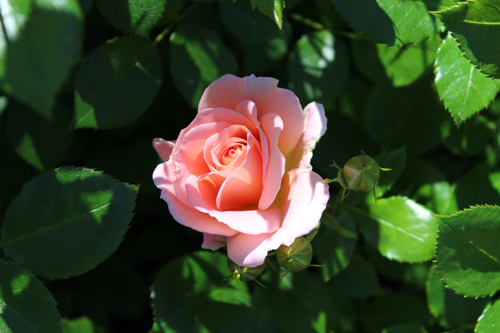
Planting and agricultural technology
Planting a Geisha is best done in the fall. Choose a sunny place. But in the southern regions it is necessary to select such a site so that at the peak of solar activity the bush is covered with diffused penumbra. As already mentioned, the flowering is very lush, because of the many inflorescences, even strong shoots tend to the ground. This feature requires tying the bush to a support. Preventive treatment will ensure healthy plant growth during the growing season. Shelter for the winter is not necessary in suitable growing areas.For abundant and bright flowering, the rose needs to be fed - in the spring and after the first wave of flowers subsides. Fertilizers for flowering are suitable for feeding. Watering is required plentiful, but not excessive - the soil should be in a moderately moist state. Faded inflorescences should be removed in time so that the resulting buds can bloom faster.
Geisha (Pink Elizabeth Arden, TANtenom)
This variety also belongs to the rose-growing company Tantau, but it appeared much earlier than the variety described above - in 1964. The author is Mathias Tantau Jr. The registration name is TANtenom. In the flower market, the rose is known as Pink Elizabeth Arden and TANtenom. In 1966, it was introduced in Australia under the name Geisha. Used for single or group plantings in the garden, can be grown as a container. This Geisha is well suited for cutting.
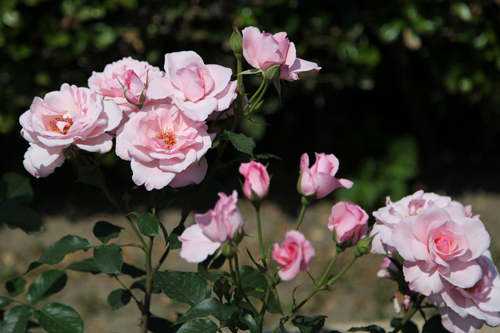
Description
Belongs to the floribund group. The bush is medium-sized, dense, upright shoots, good foliage. Height from 60 to 120 cm. Leaves are dark green, slightly glossy. Shoots bear inflorescences of 3 - 5 buds.
The bud looks more like a hybrid tea rose. The blossoming flower is cup-shaped, semi-double, with an average of about 20 petals. The size of the flower is not very large - up to 8 cm. The color is very soft, pale pink. The outer petals are larger than the inner ones; when fully opened, the wavy edges of the petals are bent outward, exposing the core with many stamens. The filament is red, the anthers are yellow. The aroma is soft.
Bloom
This Geisha belongs to the re-blooming. After the first wave of flowering, the buds appear again. In order not to delay the formation of new flower brushes, faded ones must be removed in time. Then the bush will bloom until the cold weather.
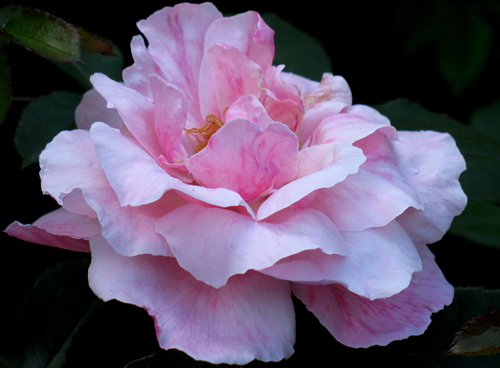
Characteristics
- Moderate winter hardiness, which allows the bush not to freeze in winter at a temperature of - 23.3 ° C. According to the US Department of Agriculture (USDA), this figure corresponds to zone 6;
- the rose has excellent immunity, even in unfavorable years it is practically not affected by powdery mildew and black spot;
- the highest resistance to damp weather, the buds do not get wet and do not lose their shape even during prolonged rains.
Planting and agricultural technology
Planting season is autumn, 3 weeks before the onset of stable cold weather. The care is not complicated and is similar to the procedures already described above. I would also like to dwell on pruning. In the spring, thinning pruning should be carried out, removing shoots growing inward, as well as branches frozen out during the winter. In warm climates, the shoots are cut by about 1/3; in cooler regions, they are shortened a little more, by about ¼ of the shoot.
Not so much is known about the following roses with the name Geisha. There is nothing surprising in this, since the varieties are old, and the flower market requires new varieties. Perhaps, among amateur collectors, these species still decorate the garden, but they are little known to most gardeners.
Next on the list is the hybrid tea variety discovered by Gerald Adriaan Van Ross in the Netherlands in 1920. Introduced in Australia in 1922 under the name Geisha. It looks like a bushy, erect plant with shoots studded with thorns. The main color of the flowers is orange, but as it fades, it becomes golden yellow. The flower is large, double, consists of 17 - 25 petals. Long-lasting flowering throughout the growing season.
The representative of the multi-flowered group called multiflora also has the name Geisha. It was under this name that the variety was introduced by Peter Lambert in 1913 in Germany. The author of this variety is Rudolf Geschwind, the year of creation is unknown. One of the parent forms is Crimson Rambler. The rose has climbing lashes capable of climbing up to 3 meters. The flowers are medium to large in size, double (26 - 40 petals).The shape is cupped, but at the moment of full disclosure, the flower becomes almost flat. Coloring - a smooth transition from white to scarlet-crimson closer to the edge of the petal. Winter hardiness corresponds to 6 - 9 USDA zones.








